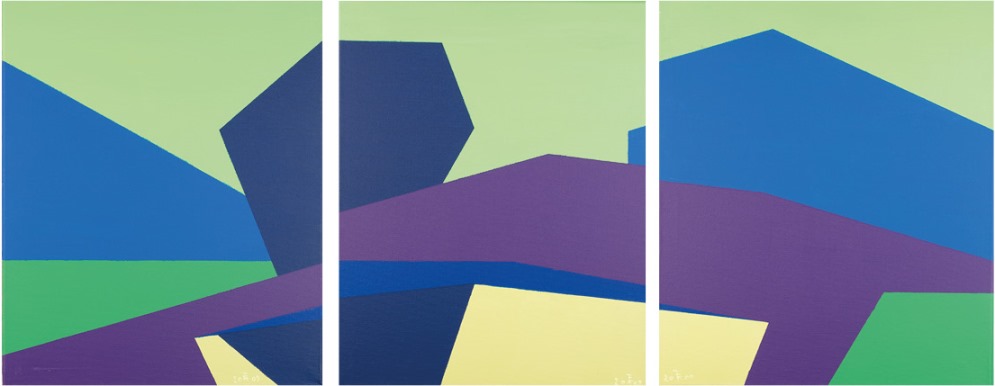Frederik “Kunngi” Kristensen (1952) is represented in Nuuk Art Museum’s collection by a series of three connected paintings from 2009. Kunngi is an eclectic artist working as a poet, a musician and a painter.
In 1975 he began at the then newly founded Grafisk Værksted, today the Art School in Nuuk. Kunngi worked with nonfigurative painting right from the beginning, but according to him what he first and foremost does is really to create images. A nonfigurative painting is for Kunngi an image which does not contain any forms resembling or repeating the reality around us.
The square recurs again and again in Kunngi’s works and, as the artist himself say, it is hard to alter a square. He tries to break and reverse the square with colours, which also colours create coherence in the nonfigurative paintings.
When painting, Kunngi chooses two out of the three primary colours – red, blue, yellow – and uses them in different mixtures. The third primary colour is hidden. In the painting hanging in Nuuk Art Museum he chose blue and yellow, while red is hidden in the violet surfaces.
Kunngi draws many small sketches with crayons before he starts painting. As he builds up the image, he creates a balance in it by drawing lines over the canvas, like a grid. He wants his pictures to be easy to look at.
The paintings in Nuuk Art Museum are made up of delimited geometric surfaces of colour laying side by side, yellow and violet and different shades of green and blue.
The paintings constitute a tripartite and, at the same time, whole image. Kunngi explains that the picture was made based on a small oblong sketch, to which he chose to assign three canvases instead of one. A tripartite painting can also be called a triptych. A triptych often consists of three different images with a common meaning. Altarpieces are often triptychs consisting of a representation of the earth in the middle, with heaven and hell on each side. The tripartition in Kunngi’s paintings gives the impression of a horizontal flow and adds a spatial feeling to the paintings.
Each of the three paintings is signed, the work being thereby not signed as a single whole picture but as three distinct ones. In this way the paintings can be seen both individually and together. Following the lines that delimit the surfaces of colour, one notices they are somewhat displaced from painting to painting: our eye needs to try and let them match. In this way, Kunngi plays with us; he himself said he wants to tease the viewer, thus establishing a very direct connection with us looking at the picture. He talks to us through the picture and demands something from our sight: not that we see something determined, but that we see, precisely, a picture. A friend of Kunngi’s remarked that his paintings never get old, they are always new in the moment we look at them – we see something different there every time.
Kunngi has been told several times that his nonfigurative paintings were not Greenlandic. At one time it was a teacher student, who came by the art school and suggested that Kunngi should have rather been painting icebergs and kayaks. Another time it was during an exhibition in Canada. These comments point out the common expectation that Greenlandic art should deal with Greenland in its motives and meanings alike. With his nonfigurative paintings, Kunngi breaks with such expectations. As Kunngi says, he does not paint because he is Greenlandic, he “paint[s] what [he] feel[s] like to paint”.
In front of Kunngi’s nonfigurative paintings, it is up to the viewer to recall figures. In other words it is the viewer who sees a Greenlandic motive or not. Kunngi painted geometrical surfaces of colour, a tripartite nonfigurative painting, but first and foremost he painted a picture.
This article was written by Stine Lundberg Hansen. 2016.

